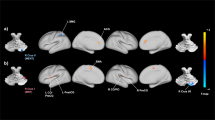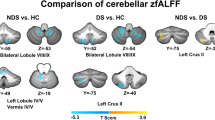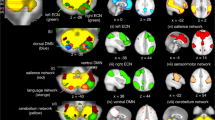Abstract
In recent years, increasing evidence of the cerebellar role in social cognition has emerged. The cerebellum has been shown to modulate cortical activity of social brain regions serving as a regulator of function-specific mentalizing and mirroring processes. In particular, a mentalizing area in the posterior cerebellum, specifically Crus II, is preferentially recruited for more complex and abstract forms of social processing, together with mentalizing cerebral areas including the dorsal medial prefrontal cortex (dmPFC), the temporo-parietal junction (TPJ), and the precuneus. In the present study, the network-based statistics approach was used to assess functional connectivity (FC) differences within this mentalizing cerebello-cerebral network associated with a specific cerebellar damage. To this aim, patients affected by spinocerebellar ataxia type 2 (SCA2), a neurodegenerative disease specifically affecting regions of the cerebellar cortex, and age-matched healthy subjects have been enrolled. The dmPFC, left and right TPJ, the precuneus, and the cerebellar Crus II were used as regions of interest to construct the mentalizing network to be analyzed and evaluate pairwise functional relations between them. When compared with controls, SCA2 patients showed altered internodal connectivity between dmPFC, left (L-) and right (R-) TPJ, and right posterior cerebellar Crus II.
The present results indicate that FC changes affect a function-specific mentalizing network in patients affected by cerebellar damage. In particular, they allow to better clarify functional alteration mechanisms driven by the cerebellar damage associated with SCA2 suggesting that selective cortico-cerebellar functional disconnections may underlie patients’ social impairment in domain-specific complex and abstract forms of social functioning.


Similar content being viewed by others
References
Clausi S, Lupo M, Olivito G, Siciliano L, Contento MP, Aloise F, et al. Depression disorder in patients with cerebellar damage: awareness of the mood state. J Affect Disord. 2019a;245:386–93.
Clausi S, Olivito G, Lupo M, Siciliano L, Bozzali M, Leggio M. The cerebellar predictions for social interactions: theory of mind abilities in patients with degenerative cerebellar atrophy. Front Cell Neurosci. 2019b;12:510.
Leggio M, Olivito G. Topography of the cerebellum in relation to social brain regions and emotions. Handb Clin Neurol. 2018;154:71–84 Review.
Lupo M, Olivito G, Iacobacci C, Clausi S, Romano S, Masciullo M, et al. The cerebellar topography of attention sub-components in spinocerebellar ataxia type 2. Cortex. 2018a;108:35–49.
Lupo M, Olivito G, Siciliano L, Masciullo M, Molinari M, Cercignani M, et al. Evidence of cerebellar involvement in the onset of a manic state. Front Neurol. 2018b;9:774.
Lupo M, Olivito G, Siciliano L, Masciullo M, Bozzali M, Molinari M, et al. Development of a psychiatric disorder linked to cerebellar lesions. Cerebellum. 2018c;17(4):438–46.
Clausi S, Iacobacci C, Lupo M, Olivito G, Molinari M, Leggio M. The role of the cerebellum in unconscious and conscious processing of emotions: a review. Applied Sciences (Switzerland). 2017;7(5):521 Review.
Hoche F, Guell X, Vangel MG, Sherman JC, Schmahmann JD. The cerebellar cognitive affective/Schmahmann syndrome scale. Brain. 2018;141:248–70.
Tedesco AM, Chiricozzi FR, Clausi S, Lupo M, Molinari M, Leggio MG. The cerebellar cognitive profile. Brain. 2011;134:3672–86.
Stoodley CJ, Schmahmann JD. Evidence for topographic organization in the cerebellum of motor control versus cognitive and affective processing. Cortex. 2010;46:831–44.
Mar RA. The neural bases of social cognition and story comprehension. Annu Rev Psychol. 2011;62:103–34.
Calder AJ, Lawrence AD, Young AW. Neuropsychology of fear and loathing. Nat Rev Neurosci. 2001;2:352–63.
Kipps CM, Duggins AJ, McCusker EA, Calder AJ. Disgust and happiness recognition correlate with anteroventral insula and amygdala volume respectively in preclinical Huntington’s disease. J Cogn Neurosci. 2007;19:1206–17.
Biswal BB, Van Kylen J, Hyde JS. Simultaneous assessment of flow and BOLD signals in resting-state functional connectivity maps. NMR Biomed. 1997;10:165–70.
Habas C, Kamdar N, Nguyen D, Prater K, Beckmann CF, Menon V, et al. Distinct cerebellar contributions to intrinsic connectivity networks. J Neurosci. 2009;29:8586–94.
Buckner RL, Krienen FM, Castellanos A, Diaz JC, Yeo BT. The organization of the human cerebellum estimated by intrinsic functional connectivity. J Neurophysiol. 2011;106:2322–45.
Krienen FM, Buckner RL. Segregated frontocerebellar circuits revealed by intrinsic functional connectivity. Cereb Cortex. 2009;19:2485–97.
Yeo BT, Krienen FM, Sepulcre J, Sabuncu MR, Lashkari D, Hollinshead M, et al. The organization of the human cerebral cortex estimated by intrinsic functional connectivity. J Neurophysiol. 2011;106:1125–65.
Olivito G, Lupo M, Laghi F, Clausi S, Baiocco R, Cercignani M, et al. Lobular patterns of cerebellar resting-state connectivity in adults with autism spectrum disorder. Eur J Neurosci. 2018a;47(6):729–35.
Olivito G, Clausi S, Laghi F, Tedesco AM, Baiocco R, Mastropasqua C, et al. Resting-state functional connectivity changes between dentate nucleus and cortical social brain regions in autism spectrum disorders. Cerebellum. 2017a;16:283–92.
Khan AJ, Nair A, Keown CL, Dakto MC, Lincoln AJ, Muller RA. Cerebro-cerebellar resting state functional connectivity in children and adolescents with autism spectrum disorder. Biol Psychiatry. 2015;78:625–34.
D’Mello AM, Stoodley CJ. Cerebro-cerebellar circuits in autism spectrum disorder. Front Neurosci. 2015;9:408 Review.
Van Overwalle F, Baetens K, Mariën P, Vandekerckhove M. Social cognition and the cerebellum: a meta-analysis of over 350 fMRI studies. Neuroimage. 2014;86:554–72.
Van Overwalle F, D’aes T, Mariën P. Social cognition and the cerebellum: a meta-analytic connectivity analysis. Hum Brain Map. 2015;36:5137–54.
Van Overwalle F, Mariën P. Functional connectivity between the cerebrum and cerebellum in social cognition: a multi-study analysis. Neuroimage. 2016;124:248–55.
Van Overwalle F, Van de Steen F, Mariën P. Dynamic causal modeling of the effective connectivity between the cerebrum and cerebellum in social mentalizing across five studies. Cogn Affect Behav Neurosci. 2019a;19(1):211–23.
Friston KJ, Frith CD, Liddle PF, Frackowiak RS. Functional connectivity: the principal-component analysis of large (PET) data sets. J Cereb Blood Flow Metab. 1993;13:5–14.
Giacondo F, Curcio G. Spinocerebellar ataxia: a critical review of cognitive and socio-cognitive deficits. Int J Neurosci. 2018;128(2):182–91.
Zalensky A, Fornito A, Bullmore ET. Network-based statistic, identifying differences in brain networks. Neuroimage. 2010;53:1197–207.
Della Nave R, Ginestroni A, Tessa C, Cosottini M, Giannelli M, Salvatore E, et al. Brain structural damage in spinocerebellar ataxia type 2. A voxel-based morphometry study. Mov Disord. 2008;23(6):899–903.
Estrada R, Galarraga J, Orozco G, Nodarse A, Auburger G. Spinocerebellar ataxia 2 (SCA2),: morphometric analyses in 11 autopsies. Acta Neuropathol (Berl). 1999;97:306–10.
Iwabuchi K, Tsuchiya K, Uchihara T, Yagishita S. Autosomal dominant spinocerebellar degenerations. Clinical, pathological, and genetic correlations. Rev Neurol (Paris). 1999;155:255–70.
Trouillas P, Takayanagi T, Hallett M, Currier RD, Subramony SH, Wessel K, et al. International cooperative ataxia rating scale for pharmacological assessment of the cerebellar syndrome. The Ataxia Neuropharmacology Committee of the World Federation of Neurology. J Neurol Sci. 1997;145:205–11.
Wechsler D, Wais R. Wechsler Adult Intelligence Scale Revised. Firenze: Organizzazioni Speciali; 1981.
Orsini A, Laicardi C. WAIS-R-Contributo alla Taratura Italiana. Firenze: Organizzazioni Speciali; 1997.
Olivito G, Lupo M, Iacobacci C, Clausi S, Romano S, Masciullo M, et al. Structural cerebellar correlates of cognitive functions in spinocerebellar ataxia type 2. J Neurol. 2018b;265(3):597–606.
Olivito G, Lupo M, Iacobacci C, Clausi S, Romano S, Masciullo M, et al. Microstructural MRI basis of the cognitive functions in patients with spinocerebellar ataxia type 2. Neuroscience. 2017b;366:44–53.
Brett M, Anton JL, Valabregue R, Poline JB. Region of interest analysis using an SPM toolbox [abstract] Presented at the 8th International Conference on Functional Mapping of the Human Brain, June 2-6, 2002, Sendai, Japan. Available on CD-ROM in NeuroImage Vol 16, No 2.
Serra L, Cercignani M, Bruschini M, Cipolotti L, Mancini M, Silvestri G, Petrucci A, Bucci E, Antonini G, Licchelli L, Spanò B, Giacanelli M, Caltagirone C, Meola G, Bozzali M. “I know that you know that I know”, neural substrates associated with social cognition deficits in DM1 patients. PLoS One 2016;11(6).
Xia M, Wang J, He Y. BrainNet Viewer, a network visualization tool for human brain connectomics. PLoS One. 2013;8.
D’Mello AM, Crocetti D, Mostofsky SH, Stoodley CJ. Cerebellar grey matter and lobular volumes correlate with core autism symptoms. Neuroimage Clin. 2015;7:631–9.
Allen G. The cerebellum in autism. Clinical Neuropsychiatry. 2005;2(6):321–37.
Fatemi SH, Halt AR. stary JM, Kanodia R, Schulz SC, Realmuto GR. Glutamic acid decarboxylase 65 and 67 kDa proteins are reduced in autistic parietal and cerebella cortices. Biological Psychiatry. 2002;52(8):805–10.
Carper RA, Courchesne E. Inverse correlation between frontal lobe and cerebellum sizes in children with autism. Brain. 2000;123:836–44.
Courchesne E, Townsend J, Saitoh O. The brain in infantile autism: posterior fossa structures are abnormal. Neurology. 1994;44:214–23.
Van Overwalle F, Manto M, Leggio M, Delgado-García JM. The sequencing process generated by the cerebellum crucially contributes to social interactions. Med Hypothesis. 2019;128:33–42.
Klinke I, Minnerop M, Schmitz-Hübsch T, Hendriks M, Klockgether T, Wüllner U, et al. Neuropsychological features of patients with spinocerebellar ataxia (SCA), types 1,2,3, and 6. Cerebellum. 2010;9:433–42.
Fancellu R, Paridi D, Tomasello C, Panzeri M, Castaldo A, Genitrini S, et al. Longitudinal study of cognitive and psychiatric functions in spinocerebellar ataxia types 1 and 2. J Neurol. 2013;260:3134–43.
Van Overwalle F. Social cognition and the brain: a meta-analysis. Hum BrainMapp. 2009;30:829–58.
Schurz M, Radua J, Aichhorn M, Richlan F, Perner J. Fractionating theory of mind: a meta-analysis of functional brain imaging studies. Neurosci Biobehav Rev. 2014;42:9–34.
Saxe R, Powell LJ. It’s the thought that counts: specific brain regions for one component of theory of mind. Psychological Science. 2006;17:692–9.
Saxe R, Wexler A. Making sense of another mind: the role of the right temporo-parietal junction. Neuropsychologia. 2005;43:1391–9.
Ma N, Vandekerckhove M, Van Hoeck N, Van Overwalle F. Distinct recruitment of temporo-parietal junction and medial prefrontal cortex in behavior understanding and trait identification. Soc Neurosci. 2012;7(6):591–605.
Harris LT, Todorov A, Fiske ST. Attributions on the brain: neuro-imaging dispositional inferences, beyond theory of mind. NeuroImage. 2005;28:763–9.
Saxe R. Uniquely human social cognition. Current Opinion in Neurobiology. 2006;16:235–9.
Decety J, Sommerville JA. Shared representations between self and other: a social cognitive neuroscience view. Trends Cogn Sci. 2003;7(12):527–33.
Cavanna AE, Trimble MR. The precuneus: a review of its functional anatomy and behavioural correlates. Brain J Neurol. 2006;129(Pt 3):564–83.
Raichle EM, MacLeod AM, Snyder AZ, Powers WJ, Gusnard DA, Shulman GL. A default mode of brain function. Proc Natl Acad Sci U S A. 2001;98:676–82.
Schilbach L, Eickhoff SB, Rotarska-Jagiela A, Fink GR, Vogeley K. Minds at rest? Social cognition as the default mode of cognizing and its putative relationship to the default system of the brain. Conscious Cogn. 2008;17:457–67.
Schmahmann JD. An emerging concept: the cerebellar contribution to higher function. Arch Neurol. 1991;48:1178–87.
Middleton FA, Strick PL. Cerebellar projections to the prefrontal cortex of the primate. J Neurosci. 2001;21:700–12.
Kelly RM, Strick PL. Cerebellar loops with motor cortex and prefrontal cortex of a nonhuman primate. J Neurosci. 2003;23:8432–44.
Olivito G, Cercignani M, Lupo M, Iacobacci C, Clausi S, Romano S, et al. Neural substrates of motor and cognitive dysfunctions in SCA2 patients: a network based statistics analysis. Neuroimage Clin. 2017c;14:719–25.
Stoodley CJ, Schmahmann JD. Functional topography in the human cerebellum: a meta-analysis of neuroimaging studies. NeuroImage. 2009;44:489–501.
Kawai Y, Suenaga M, Watanabe H, Sobue G. Cognitive impairment in spinocerebellar degeneration. Eur Neurol. 2009;61:257–68.
Van Overwalle F, De Coninck S, Heleven E, Perrotta G, Taib NOB, Manto M, et al. The role of the cerebellum in reconstructing social action sequences: a pilot study. Soc Cogn Affect Neurosci. 2019b;14(5):549–58.
Filip P, Gallea C, Lehéricy S, Lungu O, Bareš M. Neural Scaffolding as the foundation for stable performance of aging cerebellum. Cerebellum. 2019;18(3):500–10.
Funding
This research was partially supported by the Italian Ministry of Health (Ricerca Corrente). This work was financially supported by the Ministry of Education, Universities and Research (MIUR) to Maria Leggio (Grant Number RM11715C7E67E525) and by the Italian Ministry of Health to Silvia Clausi (Grant Number GR-2013-02354888).
Author information
Authors and Affiliations
Corresponding author
Ethics declarations
Conflict of Interest
The authors declare that they have no conflict of interest
Additional information
Publisher’s Note
Springer Nature remains neutral with regard to jurisdictional claims in published maps and institutional affiliations.
Rights and permissions
About this article
Cite this article
Olivito, G., Siciliano, L., Clausi, S. et al. Functional Changes of Mentalizing Network in SCA2 Patients: Novel Insights into Understanding the Social Cerebellum. Cerebellum 19, 235–242 (2020). https://doi.org/10.1007/s12311-019-01081-x
Published:
Issue Date:
DOI: https://doi.org/10.1007/s12311-019-01081-x




